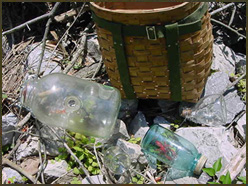We may earn revenue from the products available on this page and participate in affiliate programs. Learn More ›
Glass minnow traps have interested me since I first laid eyes on one in an antique shop years ago. Since then, I have acquired a few to extend my collection. Several are reproductions, but they’re still neat collectibles.
Glass traps originated in Europe, with France being the most famous for making hand-blown minnow and fly traps. The early American glassblowers adopted the tradition and continued to produce these minnow and fly traps. Orvis soon got into the act and began to market minnow traps under their trademark. Today a mint-condition Orvis Minnow Trap in the original box is a pricey collectible that will bring in close to $1,000 at auction.
Glass minnow and fly traps are a cross collectible-belonging to both glassware and fishing-although the fragile nature of glass makes the attrition rate very high. Commercial minnow traps are made of plastic and although they are not as highly prized, they are very collectible.
The large trap displayed in the photo is a reproduction crawdad trap purchased for my collection. In original models, bait was placed in the bottom and the trap was left overnight in a river (or stream) to be retrieved (hopefully) with a bunch of crawdads inside, which are a great bait.
I made a crawdad trap some years ago based on an article in Outdoor Life that suggested painting the outside of a gallon-sized glass jar. (Plastic is much better if you can find one.) The instructions called for cutting a hole the size of a quarter in the metal lid, and then inserting a sealed glass tube (like the ones cigars come in) with a penlight inside. With the trap baited and the penlight turned on, the rig was then left overnight in the water. The trap worked great-it had 15 crawdads in it when I retrieved it the next morning.
The minnow traps pictured with the pack basket are also part of my collection; the large trap is a reproduction, but the two delicate-looking traps are from France and can still be used as fly traps even though they’re at least 75 years old.
The “Ball Perfect Mason” blue quart jar is an example of American ingenuity. A large hole was cut in the lid, a funnel placed in the jar, and after being baited (either fish or chicken livers work well) the lid was screwed down. Tie a line to this trap and place it in moving water not more than two feet deep, and the next morning you can go to collect your bait.
Both minnow and crawdad traps are a great way to introduce youngsters to the outdoors, as they will have a fun time catching bait. These traps are also a great item to display in the office or den of the outdoorsman or woman. I have my traps displayed with my other sporting collectibles.
Should you have information or photos of collectibles, I will be glad to include items of interest submitted by www.outdoorlife.com readers in future columns. Please send an email to
